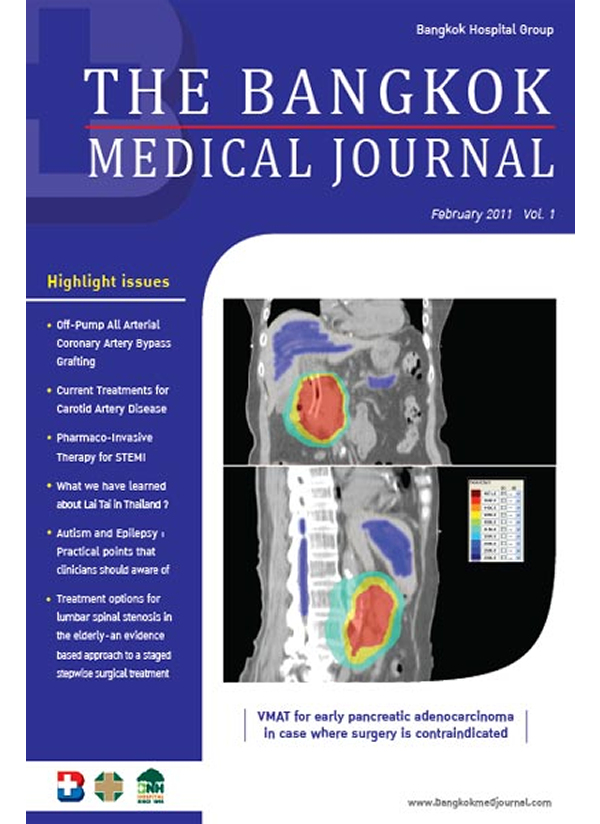What we have learned about Lai Tai in Thailand?
Main Article Content
Abstract
It was for more than a century that the mysterious sudden death, so-called “Lai Tai”, had been prevalent among villagers in Northeastern (NE) Thailand. Most victims were otherwise healthy young men who died unexpectedly during sleep. Moaning and gurgling sounds had been heard before they became unre- sponsive and expired. In some families, similar deaths had been occurred to male siblings, for over four generations, which was suggestive of genetic preponderance. It was still a local myth that these unexplained deaths were caused by a widow ghost came to take the mens’ soul at night. Several years ago, Lai Tai received media attention after a cluster of deaths of Thai workers in Singapore. Despite extensive autopsies by local authorities, the cause of death remained unidentified. So far, Lai Tai had affected our nation in many ways, from the smallest unit where wives and children had lost their husbands, fathers and the heads of family, up to the national level, that lost the significant incomes from the death of workers.
Article Details
This is an open access article distributed under the terms of the Creative Commons Attribution Licence, which permits unrestricted use, distribution, and reproduction in any medium, provided the original work is properly cited.
References
2. Nademanee K, Veerakul G, Nimmanit S, et al. Right bundle Branch Block and ST elevation, An Arrhythmogenic marker for Sudden Unexplained Death Syndrome in Young Thai Men. Circulation 1995; Suppl 92-335
3. Nademanee K, Veerakul G, Nimmanit S et al. Arrhythmogenic marker for the sudden unexplained death syndrome in Thai men. Circulation 1997;96:2595- 2600
4. Brugada P, Brugada J. Right bundle branch block, persistent ST segment elevation and sudden cardiac death: a distinct clinical and electrocardiographic syndrome: a multicenter report. J Am Coll Cardiol 1992;20:1391-1396
5. Veerakul G, Nademanee K: Dynamic changes in the RBBB and ST-Elevation Pattern in the Right Pre-cordial Leads Observed in Patients with Idiopathic Ventricular fibrillation: Evidence of Phase 2 Repolarization Abnormality. Circulation 1996;64(8):3669
6. Veerakul G, Chaothawee L, Nademanee K: Usefulness of Positioning ECG lead, at V1-3 at higher inter-costal spaces to Detect Brugada Symdrome. Circulation Suppl 2000;102(18):677
7. Veerakul G, Chaothawee L, Koananatkul B, Nademanee K. Ajmaline vs, Procainamide Challenge Test in the Diagnosis of sudden Unexplained Death or Brugada Syndrome. JACC 2002;857-856
8. Chaothawee L, Veerakul G, Kanjanapimai S, Tasnavivat P, Nademanee K. Using Ajmaline as a tool in identifying high-risk SUDS survivors. PACE 2003; Part II:26
9. Veerakul G, Likitanasombat K, Jirasirirojnakorn K, Chandanna Manthan, Nademanee K, Circardian Variation of spontaneous VF episodes in Young Thai Men with Normal Heats. Circulation 1999;100(18):4194
10. Krittiyapong R, Veerakul G, Nademanee K, Kangkagate C. Heart rate variability in patients with Brugada syndrome in Thailand. Eur Heart J 2003;24(19):1771- 1778
11. Nademanee K, Veerakul G, Mower M, Likittanasombat, Krittaaypong R, Bhuripanyo, Sitthisook S, Chaothawee L, Ying Lai M, Azen SP. The Defibrillator Versus Betablocker for Sudden Unexplained Death in Thailand (DEBUT): Circulation 2003;107:221-226
12. Vatta Matteo, Dumaine R, Varghese G, Richard TA, Schimizu W, Aihara N, Nademanee K, Brugada R, Brugada J, Veerakul G, Li H, Bowles NE, Brugada P, Antzlevitch C and Towbin JA. Genetic and biophysical basis of sudden unexplained nocturnal death syndrome (SUND), a disease alleic to Brugada syndrome. Human Molecular Genetics 2002;11(3):337-345
13. Antzelevitch C, Fish JM, DiDiego JM. Cellular mechanisms underlying the Brugada syndrome in Anzelevitch C et al. The Brugada Syndrome. From Bench to Bedside. Blackwell Futura 2005;52-77
14. Veerakul G, Kamblock J, Schwab M, Jirasirirojnakorn K, Chaothawee L, Nademanee K. Low Mortality Rate among Asymptomatic Brugada Syndrome patients: A multi-center control-randomized study comparing ICD VS. No-ICD Treatment. Circulation 2008;118S_982
15. Nademanee K, Veerakul G, Chandanna P, Chaothawee L, et al. Prevention of Ventricular Fibrillation Episodes in Brugada Syndrome by Catheter Ablation over the Anterior Right Ventricular Outflow Tract Epicardium. Circulation 2010;122:A20611


